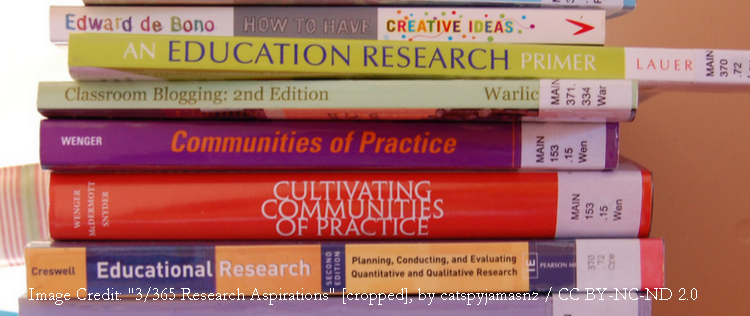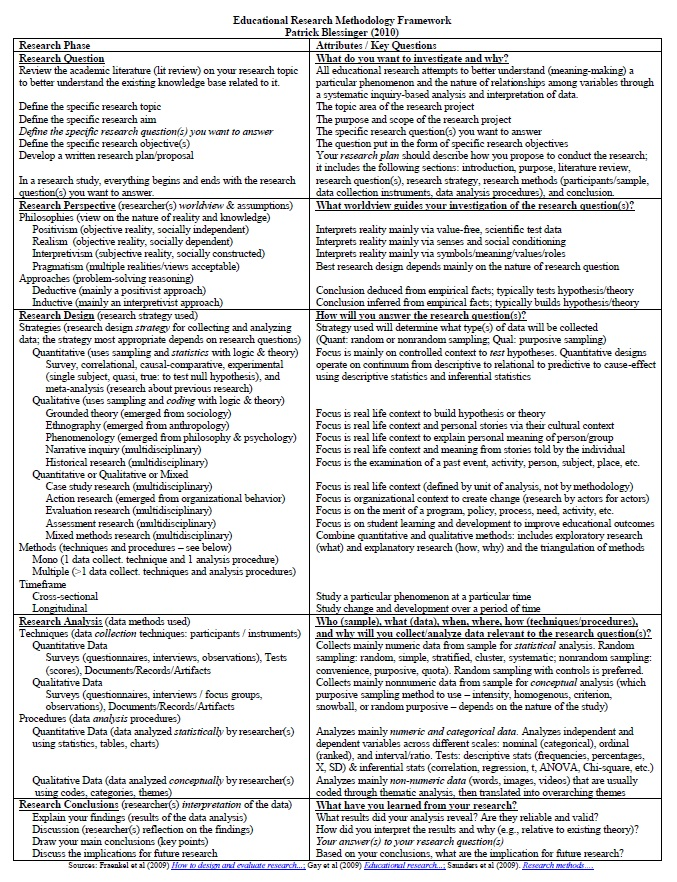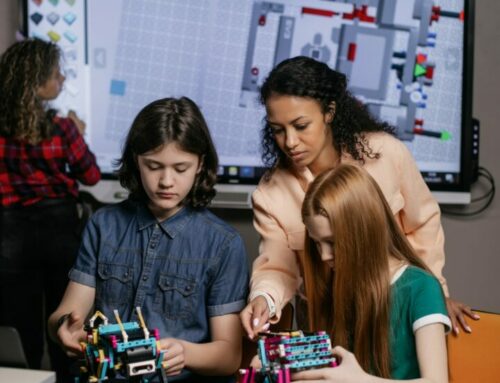Making Sense of Research
Patrick Blessinger
St. John’s University and HETL Association
CLICK TO VIEW PDF OF ERM FRAMEWORK
The aim of this article is to provide a brief overview of the educational research methodology framework and how it came into existence and how it might be most useful to higher education faculty, researchers, and students as well as others involved in educational research, inside or outside of academia. The framework may be particularly useful to those in education and the social sciences but it may also have applicability to those in the humanities as well as professional disciplines like business and the healthcare sciences.
Key definitions
Broadly speaking, research can be defined as the process of systematic inquiry to better understand the nature of a particular phenomenon and the nature of the relationships among certain variables (that are of interest to the researcher) related to that phenomenon. The phenomenon can take place in the natural world or the social world or the personal inner world of individual(s) or any combination of those worlds. The major knowledge domains (e.g., natural sciences, social sciences, humanities, arts) reflect the different realities that exist within those worlds and that emerge from those worlds. Consequently, each domain tends to orient itself around a particular mode of inquiry unique to that domain, say, for instance, using the scientific method to conduct research in the sciences. But the common denominator across these domains is the application of the systematic inquiry process to generate new knowledge by answering the research question(s) posed by and of interest to the researcher(s).
Research inherently involves the systematic analysis of empirical data (evidence), together with logic and established theory to increase the fidelity of the research results, to arrive at answers to research questions. This data may come from existing data sources such as extant knowledge bases (e.g., secondary sources such as journals, books, reports, documents, artifacts) or it may come from new data sources such as data collected by the researcher via data collection instruments (e.g., primary sources such as surveys, interviews, tests). For certain types of research, for instance, when developing an academic essay or opinion/commentary article, the author usually relies solely or primarily on existing data sources for a variety of reasons (e.g., time and budgetary constraints, secondary data sources are sufficient – the type or nature of the article may not require the author-researcher to collect new data via formalized collection methods).
In addition, for undergraduate students, for instance, learning how to examine, analyze, and reference existing data sources is a very important basic research skill and it serves as a necessary step in conducting a literature review of the research topic. All students, regardless of the type of institution they are attending or the type of academic program they are studying, must be able to master this type of preliminary research. Mastering the ability to find and examine existing data sources (i.e., immersing oneself in the existing academic literature) allows students to increase their knowledge base on their chosen topic, which in turn, puts them one step closer to learning how to do more advanced research that involves the collection of new data via formal data collection methods.
In nearly all research performed by professional researchers, as well as students in courses requiring advanced research skills, the researcher (e.g., faculty-researcher, student-researcher) utilizes both sources of data (i.e., primary/new and secondary/existing) to arrive at a more comprehensive and holistic view of the research topic that pertains to the research question(s).
In academic research, the fundamental principle that guides the research process is that everything begins and ends with the research question(s).
By using all relevant empirical data the researcher(s) attempts to better understand a particular phenomenon or phenomena in such a way that yields valid, reliable, and trustworthy results and that meet the aims, goals, and objectives of the research project.
Since everything in research revolves around the collection and analysis of data (i.e., a data-driven process), the quality of the data analyzed is therefore very important. Data quality has several characteristics such as the accuracy, completeness, relevance, timeliness, and meanings of the data. Data is also characterized by the degree of aggregation, from raw data that has not been processed or analyzed (e.g., data in its most granular form; data collected directly from the source) to summary data that has been processed or aggregated in some meaningful way (e.g., averages, standard deviations). The terms data, information, and knowledge are sometimes used interchangeably but they actually have distinct meanings. According to information theory, the main characteristic that differentiates one concept from another is the degree of processing and meaning applied to the data. Thus, raw data represents the most elementary form of communicative symbols (e.g., numbers, letters, words) and, as such, it represents the basic building blocks of communicative meaning-making (Blessinger, 2015a).
The most trustworthy results are based on research that is transparent and peer-reviewed (i.e., research that is subject to review by and input from the community of experts and practitioners in the respective discipline or field). In this way, the community of practice can be confident that the methods used and the results presented are valid, reliable, and trustworthy. Thus, to ensure the integrity of the research process, it is also important that all research adhere to commonly accepted research ethics and professional standards. It is also important to note that one type of research data (e.g., existing data vs. new data) or type of research strategy (e.g., quantitative vs. qualitative vs. mixed) is not inherently better than another type; rather, each type of research has a different purpose and focus and therefore each type of research stands on its own merits. Ultimately, the type of research strategy and method that one uses is mainly a function of the research question(s) the researcher wants to answer and the particular knowledge domain that the question(s) emerges from. As such, there is no need to rank different types of research since each type of research has a unique role to play and each type is rigorous in its own way.
The term systematic implies that the researcher follows a well-reasoned methodical process in answering the research question(s) as opposed to attempting to answer the research question(s) in a haphazard or arbitrary way. The term inquiry implies that the researcher investigates the phenomenon using sound, appropriate logic, and a critical analysis of the empirical data under investigation. A methodology is a system of established and peer-accepted strategies and methods for conducting research, along with their associated theories, principles, and rules, which are commonly defined by and used within the respective discipline/field by peer-recognized experts within that discipline/field. Thus, taken together, this framework is a skeletal structure around which related concepts can be scaffolded in an inter-related manner, showing the key concepts, linkages, and steps involved in the research process.
Purpose of the framework
This educational research methodology framework is a structural depiction that shows how key concepts are related to each other, both horizontally (concept-wise) and vertically (process-wise). This framework depicts the typical research process(es) and concepts used in educational and social science research. The potential value of the framework is that key information is depicted on a single page to serve as a convenient and practical reference/guide and the chief aim of the framework is to show the key inter-relationships among that information. In designing the framework, I tried to make it both self-explanatory and transparent so that even the novice research student can readily make sense of it.
Typically, the high level (macro) educational research process is depicted using high-level process flowcharts or similar diagrammatic representations which are helpful in understanding the macro-level view of the basic research process. Some of these flowcharts also differentiate quantitative and qualitative approaches on the same chart, which is helpful since quantitative and qualitative approaches have key differences since they work with fundamentally different types of data. Because flowcharts are high-level views, they are usually displayed on a single page.
However, high-level flowcharts often achieve brevity by sacrificing detail. In my experience in teaching research methods courses, students new to academic research (even doctoral students) are often confused about how specific (micro) research concepts (e.g., mean, standard deviation, ANOVA, thematic analysis, and coding) fit into the overall (macro) research process. Students often struggle to make these mental connections and they struggle to develop a conceptual map of the key pieces of information and they struggle to properly “connect the dots” between the macro and micro levels because the concepts and processes are new to them and because they lack experience in conducting advanced academic research.
Thus, as a teacher, it is important to understand the context (e.g., type of course, grade level and degree of difficulty of the course, students’ background and preparation relative to the course) within which one is teaching. This involves understanding the needs of the students relative to the nature of the course and the expected learning outcomes. Equipped with this basic knowledge, the teacher can then design a course that is most appropriate to the needs of the students and the course learning objectives. If the course is much too easy, students are more likely to become bored and feel unchallenged; if the course is much too difficult, students are more likely to become discouraged and feel frustrated. When students operate at either end of the spectrum, some students may feel compelled to drop the course or they may underperform academically. Thus, understanding the context of the course is important and course design plays a central role. This approach is at the heart of meaningful learning – learning that is active, authentic, experiential, and integrated (Kovbasyuk and Blessinger, 2012).
The key is to design the course so that it is challenging, rigorous, and appropriate to their learning needs and to the course learning objectives. This is another reason why the teacher (e.g., as content expert, learning architect, instructional leader, student mentor, epistemic role model) is an indispensable part of the teaching-learning process. At an increasing number of universities around the world, instructional design staff (who are experts in teaching and learning theory and design) are being hired to assist faculty in the design of courses and programs, reflecting a growing recognition of this reality.
Evolution of the framework
The idea for the framework emerged out of a necessity to better clarify key research methods and concepts to students in a college research course that I was teaching. Most of these students never had a course in formal research methods so the concepts were new and confusing to them. In order to help clarify the concepts to the students, I created a process-oriented framework that showed the inter-relationships of both macro-level and micro-level key concepts on a single page to help them better understand how the key pieces of information fit together and to present it in a highly concise way. The framework, therefore, serves as both a teaching device and as a learning aid for my students. The framework is similar to a concept map in that it shows the key concepts and the linkages between those concepts but it is different in that it is process-oriented to reflect the nature of research.
The process of creating the framework was both a creative process and an analytical process. First, it involved identifying the most important concepts the students were expected to know and the skills they were expected to master. Second, it required determining a way to show how and why those concepts relate to each other relative to the phases and steps in the research process. Third, it required determining a way to represent this information on a single page by using a concise economy of words. Fourth, it required distilling the knowledge base on research methods down to its core essence. Based on these requirements, the idea of using a framework to scaffold this information seemed to make sense and it also had the added benefits of allowing the framework to serve as both a handy road-map and blueprint for the research process. Finally, it involved creating a tabular structure of the framework, starting with the major phases, and then inserting in detailed information. Several fine-tuning iterations were required to arrive at the final version.
My experience as an ontological model builder and theoretician (from my experiential knowledge as a systems and policy analyst and as an academic teacher-researcher) helped to speed up the creation process. Also, writing poetry for many years has taught me to think more creatively and has taught me to use an economy of words to express the essence of my thoughts.
As such, the creative process is similar to the typical problem-solving process:
- identify and formulate the problem (needs analysis),
- gather relevant knowledge about the problem from multiple sources and disciplinary viewpoints,
- generate multiple ideas and alternative potential solutions to address the problem (i.e., divergent thinking),
- synthesize and evaluate the most appropriate ideas and principles,
- select and create the most effective solution that addresses the requirements of the problem (i.e., convergent thinking), and
- test and verify the usefulness and effectiveness of the solution by socializing it with the key users and constituents (e.g., students, teachers).
In this sense, the process also mirrors the higher learning process as depicted in Bloom’s Taxonomy where creative learning and the creation of new knowledge are considered to be at the pinnacle of learning objectives.
Thus, the academic research process can be thought of as a type of creative problem-solving process – a process that attempts to answer a specific research question through a systematic inquiry process. Just because the research process uses formal methods does not mean it cannot also be creative. Formal methods and creativity are not and need not be mutually exclusive. A process can be both formal and creative at the same time. There is plenty of room for creativity within the framework and within the boundaries of ethical research. As such, the process of building the framework was an exercise in what I call creative logic.
Potential value of the framework
While the macro and micro research concepts themselves are not new, as they are based on readily available source materials (e.g., college-level research methods textbooks) and commonly known concepts, the tightly integrated manner of how these concepts are depicted may help new research students to more quickly understand the inter-relationships among the key concepts. The framework draws on research concepts from the works of Fraenkel et al (2009), Gay et al (2009), and Saunders et al (2009).
The framework is not, by any means, a substitute for a research methods book or research course as there is no substitute for taking a rigorous course in research methods that is guided by a knowledgeable and experienced teacher-researcher, but it can hopefully serve as another tool to help students who are taking a course in research methods to more quickly grasp the key concepts involved as well as how and why those concepts relate to each other. Thus, not only is the framework descriptive but also explanatory. However, how to best use the framework, as a teaching and learning aid, ultimately depends on the teacher and learning objectives of the particular course.
A major challenge in constructing the framework to fit onto a single page, without sacrificing essential details, was deciding what information was most important to include – this I based on my own experience as a teacher, researcher, writer, and editor. Constructing it was therefore as much a creative process and challenge as it was an analytical process and challenge, which involved drawing on my accumulated interdisciplinary knowledge bases and skills.
Hopefully, the framework will also serve the purpose of exemplifying why creative thinking and learning is just as valuable in the educational process as critical thinking and learning. When both types of thinking are merged in a meaningful way, creative logic has the potential to emerge. The framework is discussed within the context of doctoral education in the book titled, Emerging Directions in Doctoral Education (Blessinger and Stockley, 2015d). The concept of creative thinking is discussed in the book titled, Creative Learning in Higher Education (Blessinger and Watts, 2015e). The concept of academic inquiry is discussed in the four-volume set titled, Inquiry-Based Learning (Blessinger and Carfora, 2014a, 2014b, 2015b, 2015c). As such, the framework represents an integrated synthesis of the core concepts related to educational research.
References
Blessinger, P. (2015a). Building a global knowledge society through universal lifelong education. Global Access to Postsecondary Education. Retrieved from http://www.gaps-education.org/wp-content/uploads/2015/08/The_GAPS_Think_Piece_Issue_5.pdf
Blessinger, P., & Carfora, J. M. (2015b). Inquiry-based learning for multidisciplinary programs: A conceptual and practical resource for educators. Bingley, UK: Emerald Group Publishing.
Blessinger, P., & Carfora, J. M. (2015c). Inquiry-based learning for science, technology, engineering, and math (STEM) programs: A conceptual and practical resource for educators. UK: Emerald Group Publishing.
Blessinger, P. & Stockley. D. (2015d). Emerging directions in doctoral education. Bingley, UK: Emerald Group Publishing.
Blessinger, P. & Watts, L. (2015e). Creative learning in higher education: International perspectives and approaches. NY, NY: Routledge Publishing.
Blessinger, P., & Carfora, J. M. (2014a). Inquiry-based learning for the arts, humanities, and social sciences: A conceptual and practical resource for educators. Bingley, UK: Emerald Group Publishing.
Blessinger, P., & Carfora, J. M. (2014b). Inquiry-based learning for faculty and institutional development: A conceptual and practical resource for educators. Bingley, UK: Emerald Group Publishing.
Fraenkel, J. R., Wallen, N. E., & Hyun, H.H. (2009). How to design and evaluate research in education. McGraw-Hill Education. Columbus, OH.
Gay, L. R., Mills, G. E., & Airasian, P. (2009). Educational research: Competencies for analysis and applications. Pearson Education. Upper Saddle River: NJ.
Kovbasyuk, O., & Blessinger, P. (2013). Meaning-centered education: International perspectives and explorations in higher education. NY, NY: Routledge Publishing.
Saunders, M., Lewis, P., & Thornhill, A. (2009). Research methods for business students. Pearson Education. Essex: England.
Suggested Citation:
Blessinger, P. (2015). Making Sense of Research. Higher Education Tomorrow, Volume 2, Article 11. https://www.patrickblessinger.com/ermf
Copyright © [2010-2015] Patrick Blessinger
Disclaimer
Opinions expressed in this article are those of the author, and as such do not necessarily represent the position(s) of other professionals or any institution.
CLICK TO VIEW PDF OF ERM FRAMEWORK





